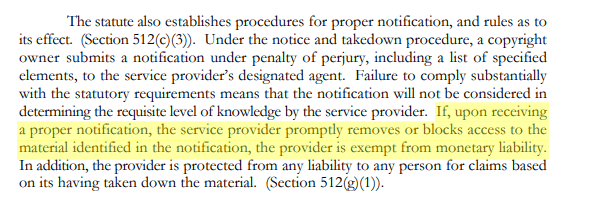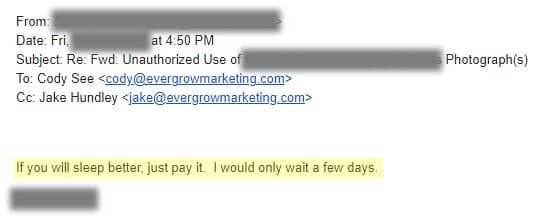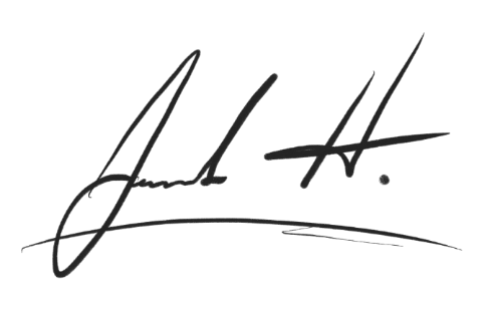>> 5 minute read
The worst part about writing papers in high school was citing your sources. Even if they were obvious, like quoting JFK. I assume that’s the case in college. I’m not sure. I dropped out.
That probably explains why my business partner and I ran into this problem a few months ago with one of our clients.
Because we signed an NDA on this deal, I can’t actually show the image we used or discuss the contents of it or which company hired the law firm to shake us down.
So just take this for what it’s worth.
Cody and I build and market websites for a living. I’ve been doing this since 2018. He’s been on board since 2019.
Since almost all of our clients are landscaping and lawn care businesses, a fair amount of them don’t have their own photography to use. We can’t have blank websites.
So we use stock photos, specifically purchased ones from 123rf.com.
The problem is that we’re industry professionals.
We’re not going to use images that were incorrectly labeled as an armyworm when it’s a webworm.
We’re also not going to use an image of a homeowner or model spreading seed with a plastic Scotts spreader when they use commercial spreaders like Lesco.
Long story short, I couldn’t find a decent image on 123rf.com, so I turned to the ol’ Google Images.
Fastforward five months and my client forwards me this:

You’ve got to be kidding me.
I can’t be too mad. I made the decision to cut a corner and it bit me in the ass.
Of course, at this time, I wasn’t entirely sure what the public domain was. But I did know images were free game there. I think I was a bit confused on what is actually labeled as such.
Still am.
Anyways, there’s a lot of fancy words and phrasing in this letter that seem pretty threatening. Fortunately, our relationship with our client was (and still is) pretty good. We reassured him we would take care of this.
Removing the image wasn’t a big deal. “Sorry. We’ll take that down” wasn’t an acceptable answer for them. Their client wanted money.
After we told them we had removed the image they thanked our client and then told us that just because we removed the image doesn’t mean their client wants to drop this.
They told us $1,500 would prevent the client from seeking further legal action.
Convenient. Since $1,500 is small enough to not go to small claims court and large enough to be a burden.
I used an image from Google and rolled the dice. Like an idiot.
However, we weren’t too worried. We were pretty confident nothing could really come of this since we removed the image within 3 hours of receiving notification.
And according to US Copyright law, Code § 512, we were protected from any financial liability due to our prompt removal.

We sent this over to the law firm issuing this claim on behalf of their client (the owner of the image) and explained we were within our rights to remove the image and not be liable for any financial responsibilities.
We waited three days but didn’t hear anything back. And since this law firm was only giving us 2 weeks to respond, we assumed they just didn’t like what we had to say and weren’t going to accept that as a response.
The whole thing just seemed like a threat.
So that left us with two options.
The first option is what I wanted to do. To go tell this law firm’s client to go pound sand.
We’re clearly protected from financial liabilities since we removed the image within a timely manner. More than timely. Impressively responsive, in my opinion.
However, fighting back always brings retaliation. And the last thing we want is retaliation from a law firm for something we clearly made the first mistake on.
We even reached out to our lawyer and looped him in on everything. Since the financial compensation amount was relatively small (too small for small claims court to be worth it) we figured fighting it might be a losing battle.
Again, to us, the amount was relatively small. That’s not to say it wasn’t a lot. It was. And we didn’t want to dip into our business savings to pay for this.
Additionally, we know in court we could beat this because the law was clear. But was there something we were missing somewhere? A loophole?
I’m also not the kind of person to roll-over and accept a loss. Which is what this would have been if we just paid it.
We asked our lawyer for advice and he just said to do whatever helps us sleep at night.

If you read the above header and thought we got out without paying the full $1,500. You’re wrong.
We paid them. In full.
We did this for one reason. But really three reasons.
The main reason is because it helped us sleep at night.
But the three actual reasons are:
1) $1,500 is too small for taking something like this to small claims court. We’d be paying court and lawyer consultation fees that would equal more than this amount.
2) The people who hired this lawfirm sued a major education company in the past and won. That wasn’t a challenge we wanted to take on.
3) We accepted the responsibility of my mistake.
That last one is important.
I made a mistake. And I accepted the responsibility and the punishment. Of course, we’re still curious how this would have played out had we fought back.
Our client thought we were getting shafted.
I think the lesson I learned most here was to accept the responsibility of your mistakes. They really do help you sleep better at night.
And you can bet your ass our library of LINCENSED images has grown exponentially since this event!
We learned that being honest with our clients is the best policy. Even when we screwed up, our client was still on our side.
We learned to pick our battles. Not every battle is worth having, especially when the victory isn’t actually coming out the “victor”.
And most importantly, we learned to just not use ANY images we don’t have explicit rights to. We also learned to document that in our processes so our employees don’t make the same mistake.
I don’t have a specific blog post for this, so I’ll include this here in case you’re curious. This would have fit better earlier in this story, but I didn’t want to detract from the main reason you started reading this in the first place.
The first question we need to ask ourselves is what images can we use. Ultimately, it’s just whoever has given you consent to use their image. It’s NOT whatever you can find on Google.
Public domain images are free to use by anyone. They’re like Yankee Doodle. No one owns them and they’re free to be used by anyone for any reason.
Just because you can find an image in Google does NOT mean it’s public domain!
It’s when an image’s copyright has expired or was never registered in the first place.
Certain images also cannot be copyrighted, like well-known symbols.
However, artists who wish to have the public use their images as if they were public domain images usually waive their copyright protections voluntarily with a “No Rights Reserved” license (CC0).
I’m still fuzzy on what that really means.
But I do know that there are a few websites where artists voluntarily upload their work for use by nearly anyone for free. A couple of them are:
Well, there’s really tons of them. But 99 Designs has a list of 31 of these sites.
A fair warning, you’re probably not going to find anything good on these sites. Public domain and anything “free” usually follows the saying, “beggers can’t be choosers”.
Here’s your best bet.
If you find an image you like and you’re unsure if it’s a public domain image and it’s not listed on one of the sites linked to above… GET PERMISSION TO USE IT.
Make sure it’s written. Whether it’s an email or a hand-written letter. Get permission.
The easiest way to get permission is to just pay for the damn licensing. Most photo / image sites have some kind of purchase or subscription plan.
And let me tell you what, $2 – $5 per image is a lot cheaper than a $1,500 shakedown.
Multiply that by how many images you stole and you’ll be wishing you could have paid $10 per image.
A lot of the image sites that 99 Designs listed above also include images from artists that still retain the copyright to their images, but you can typically purchase them individually or with a subscription plan.
Of course, my favorite site right now is 123rf.com.

